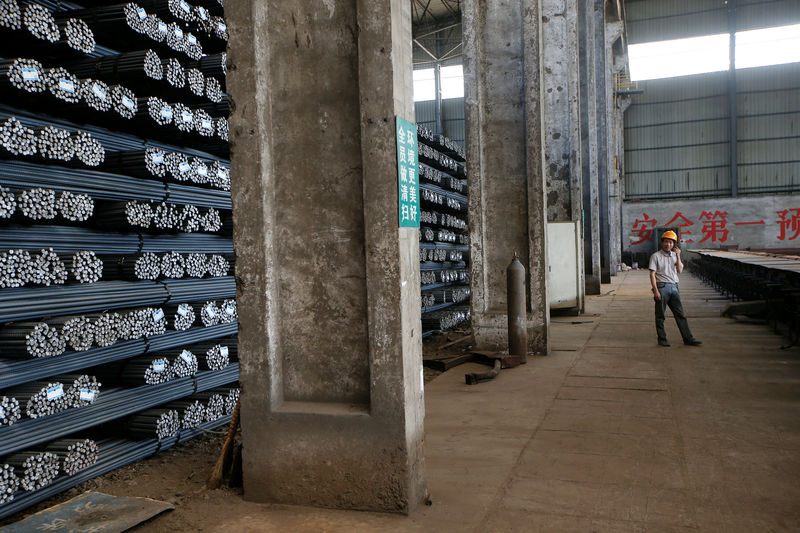(The opinions expressed here are those of the author, a columnist for Reuters.)
By Clyde Russell
LAUNCESTON, Australia, May 23 (Reuters) - China's imports of iron ore are likely to have maintained their recent strength in May, as top suppliers Australia and Brazil continue to squeeze market share from smaller rivals.
Imports this month are likely to come in around 84.76 million tonnes, according to vessel tracking data compiled by Thomson Reuters Commodity Research and Forecasts.
This would represent a modest increase on April's official customs figure of 83.92 million tonnes, but be slightly below the 85.77 million tonnes reported for March.
Ship-monitoring data doesn't exactly align with customs figures due to timing issues, but the margin of error over the first four months of 2016 was only 1.5 percent.
The data shows that 547 vessels are expected to have discharged iron ore cargoes by May 31 at Chinese ports, although it's possible that some of these ships may be delayed in berthing, thereby pushing their cargoes into the following month's official numbers.
The ongoing robustness in iron ore imports make sense given China's steel mills are continuing to crank out products at elevated rates amid hopes for a surge in demand on the back of increased infrastructure spending and an improvement in building construction.
China's crude steel output rose 0.5 percent to 69.4 million tonnes in April from the same month a year earlier, according to data from the World Steel Association. figure was slightly down on the record 70.7 million tonnes produced in March, but it's worth noting that on a daily basis April output of 2.31 million tonnes per day exceeded March's 2.28 million.
Amidst the fairly positive outlook for iron ore demand in the world's largest importer, there is one factor that may be bearish, namely the rising inventories of the steel-making ingredient at ports.
Stockpiles topped 100 million tonnes last week for the first time since December 2014, rising from 99 million tonnes in the week to May 13 to 101.04 million in the week to May 20, according to data from industry website Custeel. CUS-STKOT-IORE
This shows that iron ore imports aren't being consumed by mills quite as quickly as they are arriving, but the inventories are still some way below the peak of 113.4 million tonnes reached in June 2014.
The iron ore import data also shows the increasing dominance of Australia, and to a lesser extent Brazil, in supplying China.
Australia shipped 271.408 million tonnes of iron ore to China in the first five months of 2016, according to Thomson Reuters Commodity Research and Forecasts.
This equated to a 66.9 percent market share of the total 405.364 million tonnes imported by China, well ahead of Brazil on 20.9 percent share.
Comparing the Thomson Reuters data to the official figures for 2015 shows that Australia's 66.9 percent share for the January to May period is up on the 63.7 percent it achieved for the whole of last year.
Brazil's market share in the first five months has risen to 20.8 percent, up from 20.1 percent for 2015.
Together, Australia and Brazil accounted for 87.8 percent of China's iron ore imports in the first five months of the year, up from 83.8 percent in 2015.
SMALLER PRODUCERS DOWN, NOT OUT
China's imports from number three supplier South Africa were 16.01 million tonnes in the first five months, giving it a 3.9 percent market share, which is down from 4.7 percent for 2015.
Ukraine, the fourth-largest supplier, saw its market share drop to 1.4 percent in the January-May period from 2.1 percent in 2015.
This shows that it's becoming increasingly harder for the smaller iron ore producers to compete against the Australian and Brazilian juggernauts.
But, conversely it also shows that it's quite difficult for the huge, low-cost miners to completely wipe out smaller rivals, as might have been expected.
With the cost of mining a tonne of iron ore and getting to an export port in Western Australia state dropping to around $13-$15 a tonne at the mines owned by Rio Tinto (LON:RIO) RIO.AX and BHP Billiton (LON:BLT) BHP.AX , it would be logical to expect that only Brazil's Vale VALE5.SA would be able to compete.
But South Africa's Kumba Iron Ore KIOJ.J is managing to hang on, as are producers in other countries, such as Canada and Chile.
It's true that outside of South Africa, the market shares are tiny, with Canada and Chile each commanding about 1 percent of China's imports, but the point is that their share for the first five months is about the same as it was for 2015.
Despite holding all the aces, the big three iron ore miners appear unable to kill off their smaller competitors.
This suggests that in the absence of a major surge in demand iron ore prices will struggle to mount a sustained rally as producers will still be keen to fight for market share.
(Editing by Richard Pullin)
